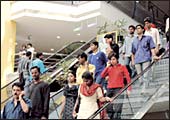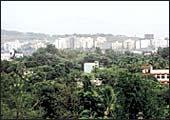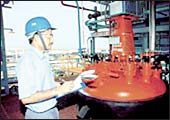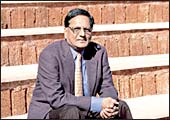 |
| Hi-Tec City: Glass, chrome
and code |
This
writer first saw the future of Hyderabad in a bookstore that,
by the time this magazine hits the news stands, will no longer
be. "Roadwork," said the man behind the counter when
asked why the store, the largest (and finest) repository of used
books of every genre (pulp romances to serious non-fiction) in
the city and probably amongst the best of its ilk in the country
was closing down. "This building is being demolished to make
way for a road."
Roadwork and demolitions have become a way
of life in Hyderabad. Buildings abutting some arterial thoroughfares
have medium-sized numbers painted on in red; 15ft, say some, 16ft,
say others; the numbers indicate the magnitude by which the roads
are to be widened. Often enough, that means buildings have to
come down. Like the building in which the bookstore is (was) housed,
they do. This is Hyderabad, not Shanghai. This is India, not China.
"Try this out anywhere (else) in India," says T.V. Mohandas
Pai, CFO, Infosys. "It is not easy." "It is all
about visible action on the ground," says Kiran Karnik, President,
nasscom, India's National Association of Software and Service
Companies.
| Hyderabad's reinvention is
evident in the urban renewal and infrastructure enhancement
the city is witnessing, and in its residents' attitude to
consumption, and partying. |
 |
 |
| ON-THE-MOVE: Roadwork and demolitions
to facilitate them are a way of life |
NEW WINGS: The
new international airport is work in progress |
 |
 |
| MALL GAME: Hyderabad's renaissance has
been accompanied by a consumption boom |
TUNING IN: The city that works hard,
plays harder, even on weekday nights |
Infosys recently announced its intention to
build its largest campus in the country, spread across 550 acres
(at a cost of Rs 1,250 crore) in Hyderabad. In an interview with
this magazine (see In Four Years, This Will Be The Number One
State), Andhra Pradesh Chief Minister Y.S. Rajasekhara Reddy says
that five of the country's largest textile companies will soon
have manufacturing facilities in the city; he adds that Andhra
will soon announce a very large investment in the automobile sector,
but refuses to specify whether this will be in Hyderabad.
SemIndia, a consortium promoted by non-resident
Indians working towards establishing a $3 billion (Rs 13,500 crore)
semiconductor manufacturing facility in India has announced that
Hyderabad is its preferred location (The consortium signed a Memorandum
of Understanding with the state government in February this year).
In the nine months between April 2005 and
January 2006, 127 software firms have set up shop in Hyderabad.
And all this in a city that has emerged the capital of India's
life-sciences industry and which Utkarsh Palnitkar, Indusrty Leader,
Health Sciences at Ernst & Young India calls "the hub
of the biopharmaceuticals industry." There's something happening
in Hyderabad.
Same Old, Same Old
The thing is, Hyderabad has been here before.
In 1998, when then Chief Minister Nara Chandrababu Naidu catalysed
the creation of Hi-Tec city, Hyderabad was spoken of as Cyberabad,
the next big (after Bangalore) destination for it companies. Not
content with that, the man also facilitated the creation of Genome
Valley, a Silicon Valley inspired borough that would, he reckoned,
serve as the base for India's biotech industry.
While more than a few it companies and several
hi-tech biotech start-ups did make the city their home, however,
Hyderabad didn't exactly become the next big thing. Between 2000
and the middle of 2004 Bangalore went through an urban mini-renaissance,
Chennai got its act together and successfully promoted one of
its suburbs Siruseri as the ideal destination for it firms, and
Pune's proximity to Mumbai, India's commercial capital, paid rich
dividends at a time when the economy and the stock market were
on a roll.
HOW HYDERABAD COMPARES
Hyderabad faces tough competition
from Chennai, Bangalore and Pune |
 HYDERABAD HYDERABAD
POPULATION: 5.5 million
RULING PARTY: Congress
CHIEF MINISTER: Y.S. Rajasekhara Reddy
The momentum is clearly with the city that has emerged
the capital of the Indian life sciences industry: several
infrastructure projects are works in progress, the landmark
Fabcity project is to be housed here, as will Infosys' largest
campus, and the government seems to have struck the ideal
rural-urban balance.
 BANGALORE BANGALORE
POPULATION: 7 million
RULING PARTY: JD(S)-BJP
CHIEF MINISTER: H.D. Kumaraswamy
Two years of neglect hasn't done anything for Bangalore's
claim that it is a city of the future. Strangely enough,
they haven't hurt the city too badly with the cluster effect
(and salubrious climate) still continuing to draw companies.
And the new Chief Minister has promised to set things right.
 PUNE PUNE
POPULATION: 3.8 million
RULING PARTY: Congress-NCP
CHIEF MINISTER: Vilasrao Deshmukh
Pune is as close as close can be to India's commercial
capital Mumbai. It also boasts more centres of higher learning
than any other city. Not surprisingly, its steady progress
as a preferred destination for new-age firms-it is already
the capital of India's auto industry-has accelerated in
recent times.
 CHENNAI CHENNAI
POPULATION: 6.4 million
RULING PARTY: AIADMK
CHIEF MINISTER: J. Jayalalithaa
Its suburb Siruseri promises to be the most happening
IT-borough in all Asia, Nokia has invested in a manufacturing
facility and a telecom park (in a special economic zone),
and it boasts a vibrant traditional base of auto companies
(including Korean car major Hyundai and Ford).
|
In the 2004 elections, Naidu's Telugu Desam
Party lost to the Congress; the former's mantra of urban-renewal
hadn't made him popular with Andhra's agricultural community.
The new government, headed by Rajasekhara
Reddy was expected to go all out to assuage the concerns of the
rural and agricultural populace and it has done just that: the
state's 2006-2007 budget has set aside Rs 10,000 crore for irrigation
projects; this amount is 61 per cent of the planned outlay of
Rs 19,551.9 crore for the year. Finance Minister K. Rosaiah points
out that the allocation to irrigation is a 51 per cent increase
over last year's and claims that no other state in the country
pays as much attention to the sector.
| Hyderabad has become the epicentre
of India's pharmaceutical and biotech industry; the city plays
host to some 500 pharma firms. |
 |
| TOMORROW'S WORLD: ICICI
Knowledge Park at Genome Valley |
 |
| NEW ORDER: A worker at Divis,
one of India's newest and hottest pharmaceutical companies |
 |
| FRONTRUNNER: K. Anji Reddy,
Chairman, Dr Reddy's Laboratories |
The popular consensus, after Reddy came to
power, was that Andhra Pradesh would focus on the agricultural
and rural sectors to the exclusion of all else (this, after all,
was what the new government that came to power in Karnataka in
2004 did for almost two years, one reason for Bangalore's ills).
That hasn't happened. The new government
has committed investments of over Rs 10,000 crore towards upgrading
Hyderabad's urban infrastructure. It hasn't shunned business and
businessmen the way Karnataka's government did after the 2004
elections. For instance, in August 2005, in a meeting with Reddy
Infosys Chairman and Chief Mentor N.R. Narayana Murthy pointed
out that English not being a medium of instruction in the government
schools was one reason for the widening gap between the haves
and the have nots; in late January 2006, Reddy announced that
English, not Telugu, would be the medium of instruction in all
government schools.
"There seems to be a political will
to build Hyderabad into a great city," says Kiran Mazumdar-Shaw,
Chairman and Managing Director, Biocon. "The first thing
that strikes you when you visit the city is that the infrastructure
is good and the government appears committed to building infrastructure."
"The state government has been very proactive and has treated
us well," adds Infosys' Pai, in the context of the company's
decision to build its largest campus in the city.
The Tipping Point
Every renaissance needs a tipping point.
The one for Hyderabad's reinvention would have to be SemIndia's
decision to locate its chip fabrication facility in the city.
With a proposed investment of $3 billion (Rs 13,500 crore) over
several stages-the first stage involves an investment of $75 million
(Rs 337.5 crore)-the SemIndia fab, as it is populary known, is
working with the state government to set up the 1,200-acre Fabcity
that will not only house the fab project but also multiple fab
units and hundreds of suppliers that the campus hopes to attract
over time. At peak flow, the SemIndia project will produce 30,000
wafers a month, or 40 million chips a year.
"Sometime in September 2005, I was getting
ready to make my first presentation about our industry and was
quite impressed with the fact that most officials were already
familiar with much of what I wanted to say,'' says Vinod Agarwal,
President and CEO, SemIndia. Later, he adds, he was impressed
by the fact that Hyderabad was a clean city (compared to several
others in India) and thought that this would be a good place to
live and work. As he pointed out in February when he signed the
MoU with the state, "Nowhere has anybody signed an MoU within
a week of announcing the project location.''
Part of Hyderabad's renaissance has also
come at Bangalore's expense; the latter's infrastructure crumbled
between 2004 and 2006, and this, coupled with the apathy of the
local government, caused several companies to look to other cities
such as Chennai, Gurgaon, Noida, Pune, and Hyderabad (a new government
is now in place in Karnataka and the new Chief Minister H.D. Kumaraswamy
has made all the right noises thus far).
THE CHALLENGES OF DEVELOPMENT
What Hyderabad needs and what
it is doing towards that. |
 |
| IT's best: Hi-Tec city plays host
to IT's best-known names like TCS (left) |
International Airport: Under construction. Will be
operational by early 2008. Equipped to handle 22 flight movements
an hour and 7 million passengers a year.
Better and More Roads: Roadwork is in progress.
By 2008, the city will have an outer ring road, an eight-lane
expressway that is some 160 km long (total cost: Rs 3,000
crore); four new flyovers are also being constructed (the
city is seeking funding for 24 more flyovers and 2 railway
overpasses from the Jawaharlal Nehru National Urban Renewal
Mission).
Decongesting the City: At planning stage. The city
has planned 22 townships along the new outer ring road.
Parking: Norms have been revised to encourage builders
to provide more parking; tenders will be floated in the
next couple of months for parking complexes in six to seven
locations.
Urban Transport: Hyderabad has 2 million vehicles
and registers 7 million vehicle movements a day. The share
of public transport in this is 40 per cent. The government
wants to increase this to 55 per cent in the next four years
by which time the first phase (60 km) of the metro rail
project will be complete.
Water: The state may crow about the fact that it
got the Fabcity project because it agreed to meet SemIndia's
demand for 20 million gallons a day, but poor infrastructure
and distribution means most residents don't get as much
water as they'd like. The state is investing around Rs 2,000
crore through various projects (including one that will
pipe water from the river Krishna to the city) and is also
tapping the national urban renewal mission for funds.
Power: The city has no problems meeting the current
peak demand of 20 million units per day. While there is
some concern that no new thermal power generation plants
are expected to go on stream before 2008-09, this is offset
to some extent by gas finds in the Krishna Godavari basin.
The key will be pipelines, including one in which the state
is a partner, making gas available to power projects such
as GVK Power's Jegurupadu Phase II as soon as possible.
|
And part of it has also come from initiatives
taken by previous governments that have made Hyderabad the de
facto capital of the Indian life sciences industry (at last count
the state had some 2,500 pharma and 75 biotech companies with
bulk of the activity being in and around Hyderabad). Reddy's government
has carried this focus forward by proposing a special economic
zone for pharmaceuticals at Vizag, Andhra Pradesh's second most
important city.
Hyderabad already boasts the ICICI Knowledge
Park, where several R&D hotshops are located, and the S.P.
Biotech Park, a campus dedicated to the manufacture of biotechnology
products that is conveniently located next to the knowledge park.
"All this could provide Hyderabad a distinct advantage over
other geographic locations," says Ernst & Young's Palnitkar.
Here To Stay?
The buzz about Hyderabad becoming one of
the most happening investment destinations in the country is also
reflected in a consumption boom in the city. "We call it
the Chandigarh of South India," says Kishore Biyani, Managing
Director, Pantaloon Retail; his company has already invested Rs
250 crore in Hyderabad and will do an additional Rs 500 crore
over the next two years. Already, 18 per cent of the company's
revenues come from the city.
| "In Four Years, This Will Be The Number
One State" |
 The
Andhra Pradesh assembly is in session, the Union Finance Minister
is in town, but Chief Minister Y.S. Rajasekhara Reddy
manages to fit Business Today into a 15-minute slot.
Excerpts: The
Andhra Pradesh assembly is in session, the Union Finance Minister
is in town, but Chief Minister Y.S. Rajasekhara Reddy
manages to fit Business Today into a 15-minute slot.
Excerpts:
Why should an investor come to Hyderabad? Bangalore
is still it for IT. Pune is close to Mumbai. Chennai has
a thriving base of IT and auto companies....
Just minutes before you walked in we have learnt that a
major investment in the automobile sector is coming to the
state. I cannot reveal anything more than this at the moment.
Other than trying to be proactive and quick in our responses
we have tried to look into industry needs and the most crucial
among them are those related to infrastructure. In the next
3 to 4 years, this will be the number one state in the country.
Apart from IT, what are the other sectors on your radar?
I have just told you about the major investment in the
auto sector. In the next one year, 10 to 15 important textile
players are going to set up shop here. At least five of
them would be in Hyderabad and about five to 10 in Vizag.
We now want to focus on food processing as well.
What do you see as lessons from Bangalore's experience?
Bangalore is clogged. We should run ahead. We started the
work on the international airport three years later than
Bangalore but will complete it at least a month or two ahead
of them. We are planning keeping in mind needs 15 to 20
years from now.
|
Hyderabad's dozen-odd pubs do brisk business,
with special nights dedicated to retro music, salsa, and women
the current rage; it's hard to find standing space at night-spots
such as Ahala at the Taj Krishna or Dublin at the ITC Kakatiya
Sheraton, even on week nights; and the city's tony shopping district
Somajiguda is replete with the outlets of popular Indian designers.
Pantaloon's Hyderabad Central mall offers 250,000 sq. ft. of shopping
space; another mall, GVK One, which will be ready by the end of
2006 will offer 650,000 sq.ft. Dining out options include everything
from sushi to Belgian waffles to meat cooked in khau-SWE, a Burmese-style
gravy.
All these are important because Hyderabad
still figures behind Bangalore and Pune in the list of preferred
places to work for it pros, according to most executives in the
industry. "Hyderabad still needs to improve in terms of quality
of life and become more cosmopolitan," says Infosys' Pai,
"but this is an evolutionary process and it is happening."
Pubs, nightclubs and malls are only part of the equation; water,
power, housing, sewerage, traffic management, law and order, and
quality of schools and colleges are as important.
Legacy reasons may mean that Hyderabad never
catches up with Bangalore, but given the state government's pro-rural,
and pro-agricultural stance, the city's recent progress is unlikely
to attract the kind of backlash Bangalore's did. That could make
its economic growth, much more rapid, and much more consistent.
|









 HYDERABAD
HYDERABAD BANGALORE
BANGALORE PUNE
PUNE CHENNAI
CHENNAI



 The
Andhra Pradesh assembly is in session, the Union Finance Minister
is in town, but Chief Minister Y.S. Rajasekhara Reddy
manages to fit Business Today into a 15-minute slot.
Excerpts:
The
Andhra Pradesh assembly is in session, the Union Finance Minister
is in town, but Chief Minister Y.S. Rajasekhara Reddy
manages to fit Business Today into a 15-minute slot.
Excerpts: